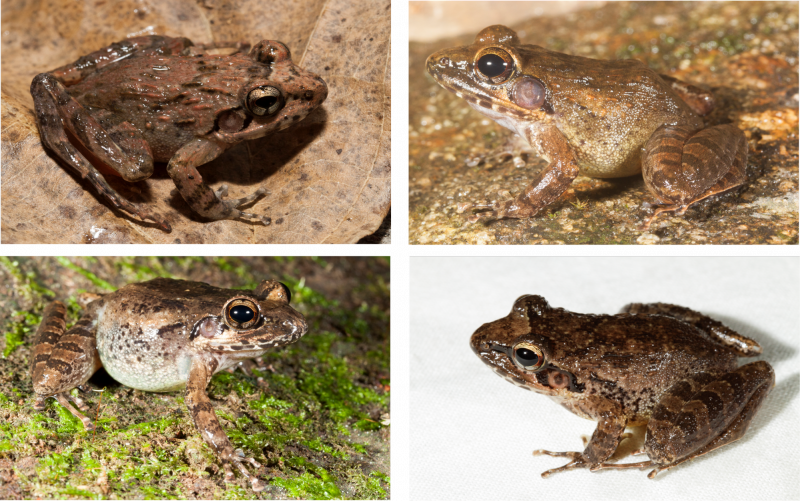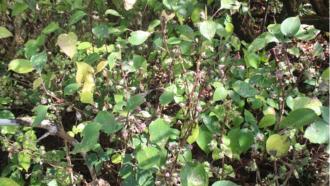
Some cryptic species of frogs in the Western Ghats (Left Top: Indirana semipalamata (Image credits: Saunak Pal), Left-Bottom: Indirana beddomii (Image Credits: Saunak Pal), Right-Top: Indirana duboisi (Image Credits: K P Dinesh), Right-Bottom: Indirana gundia (Image credits: S P Vijayakumar)
A new study proposes different approaches to tell apart two species that look identical to plain eyes.
When one thinks of a species of animals, we often picture a being, looking at which, we can quickly tell its name! But nature has its ways, and many species of animals resemble one another so much that it is hard to tell them apart by the looks. Cryptic species, as they are called, are all around us — from African elephants to tiny frogs. Scientists resort to looking at the genes to tell two such species apart. In a recent study, researchers have looked closer at endemic frogs in the Western Ghats, a biodiversity hotspot, to identify their evolutionary history.
“Since biologists have long classified species on the basis of morphology, and lay persons think of new species as things that look different, the idea that two individuals or populations could look identical but belong to different species is hard to accept” says Kartik Shanker. He is an associate professor at the Indian Institute of Science and an author of the study.
The study, published in the journal PLOS One, was carried out by researchers from Columbia University, USA, Indian Institute of Science (IISc), Bengaluru, and University of Oxford, UK. It explores the presence of cryptic species in two genera of frogs—Indirana and Walkerana—that are found only in the Western Ghats. The study was funded by grants from the Critical Ecosystem Partnership Fund (CEPF), the Ministry of Environment, Forests and Climate Change (MoEFCC), Council for Scientific and Industrial Research (CSIR) and the DBT-IISc Partnership Programme.
“Cryptic species offer a window towards understanding how species evolve,” says Vijay Ramesh, the lead author of the study. He is a PhD student at Columbia University, who is currently studying conservation biology and landscape genetics. While previous studies have suggested the presence of several variations and undescribed lineages of these ancient frogs, this study presents the first evidence to support the claim. “You might observe an Indirana semipalmata individual in Periyar National Park, Kerala and a few hundred kilometres apart, you will probably see another individual that is morphologically similar to Indirana semipalmata, but is in fact Indirana beddomii,” adds Kartik.
The researchers sampled frogs from the two genera across the heterogeneous landscape of the Western Ghats. They took detailed measurements of the body, out of which ten characters, such as head length, eye diameter, arm length, among others, to compare how similar the species are in their appearance. Although this data showed individuals that are alike, it was not sufficient to delineate cryptic species from one another.
Here’s where the researchers turned to genetics. “By using genetics, in conjunction with geography, we can distinguish a cryptic lineage from another, even if they look similar,” explains Vijay. The researchers used tissue samples to extract and sequence DNA from individual frogs and used additional genetic data that was readily available for these species. The researchers then built evolutionary trees, which trace the origins of the species, to answer how the two genera evolved.
Besides, the study also considered the geographical distance of regions where the species of the two genera were found. “We wanted to apply this idea to understand if species sampled far apart from one another exhibit distinct morphological features,” explains Vijay. The data from these three techniques of morphology, genetics and geography was used to make the data more robust before meticulously analyzing it with statistics.
Genetic analysis, conducted by the researchers, revealed the presence of distinct lineages in the Indirana and Walkerana genera. It also showed that the most recent common ancestor of the two genera split around 43 million years ago! The researchers further confirmed if these cryptic species, from different genera, were closely related, by comparing the morphological data with the evolutionary trees. It was found that cryptic species were found across the two distant lineages.
“One of the hypotheses that explains why a species is cryptic is the ‘recent divergence hypothesis’. It states that these species have split from their ancestral lineage recently, and hence, have not had enough time to develop distinct morphological features. However, this was not the case for Indirana and Walkerana” says Vijay. “The other hypothesis that could explain our results is the ‘phylogenetic niche conservatism’, where species tend to retain ancestral traits over evolutionary periods.”
The study shows that information on cryptic species cannot be obtained by studying just morphology; it requires multiple criteria to help identify such lineages. “We are beginning to realize that the current estimates of frog species in the Western Ghats might be lower as it does not consider cryptic species,” opines Vijay. Identifying cryptic species, with better mechanisms of detection will provide a better understanding of their distribution patterns and their evolution. They could also dictate conservation policies, especially at a time when amphibians all over the world are on the brink of extinction.
This article has been run past the researchers, whose work is covered, to ensure accuracy.






